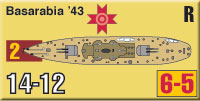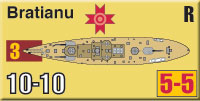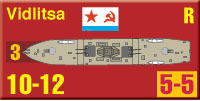| River Battleships:
Scenario Preview, Part Two
by Mike Bennighof, Ph.D.
October 2021
 This chapter of Panzer Grenadier: River Battleships includes what might have been the only battle between river monitors during World War II. These vessels’ real purpose was to provide mobile artillery support along the rivers of Eastern Europe, where roads were few and motorized artillery scarce. River monitors were very much the river-bound equivalent of armored trains. This chapter of Panzer Grenadier: River Battleships includes what might have been the only battle between river monitors during World War II. These vessels’ real purpose was to provide mobile artillery support along the rivers of Eastern Europe, where roads were few and motorized artillery scarce. River monitors were very much the river-bound equivalent of armored trains.
I wanted to add river monitors to Panzer Grenadier because, as far as I know, no one has ever created a tactical World War II game about river monitors. I’m not sure they’ve ever appeared in a game at any scale that I didn’t design myself. But we’ve filled a whole game with them, with rules for moving and firing and stuff all so they can fight each other.
The second chapter of River Battleships takes place on the lower reaches of the Danube. This is the main event, with the two largest monitor powers – the Soviet Union and Romania – squaring off on the big river. These two also have some ground forces included in the River Battleships set, so we get to use the full range of Panzer Grenadier rules to fight on land and river. Let’s have a look at the scenarios.
Chapter Two
Delta Blues
Scenario Five
Delta Dawn
22 June 1941
 Romanian troops did not immediately enter Soviet territory, but the monitors of the Danube Flotilla set out from their base at Galati to probe for their Soviet counterparts. Some kilometers down river they met the enemy, and shots were fired. Romania’s four years of destructive war began on the Danube. Romanian troops did not immediately enter Soviet territory, but the monitors of the Danube Flotilla set out from their base at Galati to probe for their Soviet counterparts. Some kilometers down river they met the enemy, and shots were fired. Romania’s four years of destructive war began on the Danube.
Conclusion
This action probably did not take place, at least not in the form that this scenario takes. Both flotillas reported exchanging fire with the other, but offered no details, and it’s just as likely that they were fired on by short batteries, or no shots were fired at all and jumpy bridge crews on the first day of the war said that there were. This possible encounter, however, is one of the very few between river monitors during the Second World War.
Notes
An exchange of fire won’t do here – the monitors and gunboats are going to have to inflict actual damage on each other, which means they’re going to have to get close and shoot it out. The Romanian monitors are tougher than the Soviet ones, but the Soviets have a bunch of pesky little river tanks zipping around to help out.
Scenario Six
Marines Land
26 June 1941
 The lower stretches of the Danube River formed the border between the Soviet Union and Romania. The Soviet Danube Flotilla, headquartered at Ismail on the river’s north bank, could not reach the Black Sea without passing Romanian fortified positions at Chilia Veche and Peripava on the south bank. These two locations – the south bank’s only instances of dry land amid the marshes – had been occupied by the Romanian Marine Regiment. The Soviets set out to eject them and clear the way for the flotilla to evacuate Ismail. The lower stretches of the Danube River formed the border between the Soviet Union and Romania. The Soviet Danube Flotilla, headquartered at Ismail on the river’s north bank, could not reach the Black Sea without passing Romanian fortified positions at Chilia Veche and Peripava on the south bank. These two locations – the south bank’s only instances of dry land amid the marshes – had been occupied by the Romanian Marine Regiment. The Soviets set out to eject them and clear the way for the flotilla to evacuate Ismail.
Conclusion
Unlike most scenarios in this book, this scenario is based on an actual action. The Romanian monitors did not arrive in time to interrupt the Soviet landings, and the Soviet marines – just one rifle and one machine gun company – overwhelmed the Romanian 15th Marine Battalion. All of the Romanians were killed, captured or fled into the swamps. The Soviet Danube Flotilla’s escape route had become a little easier to manage.
Notes
The Soviets have to land their marines, and then those marines have to beat the hell out of the Romanian marines. There aren’t many Soviets, but they’re much better troops than the Royal Romanian Marine Regiment.
Scenario Seven
Guns of Vilkovo
June 1941
 Had the Romanian Danube Flotilla chosen to pursue its Soviet counterparts down the Danube to the Black Sea, they would have to pass under the Soviet Battery Number 7 at Vilkovo on the north bank, sited to overlook the juncture of the Danube and the Ochakivske, a distributary channel flowing from the Danube northeastwards also into the Black Sea. As long as the Soviet guns remained there, Romanian shipping could not move freely between the Danube and the sea. Had the Romanian Danube Flotilla chosen to pursue its Soviet counterparts down the Danube to the Black Sea, they would have to pass under the Soviet Battery Number 7 at Vilkovo on the north bank, sited to overlook the juncture of the Danube and the Ochakivske, a distributary channel flowing from the Danube northeastwards also into the Black Sea. As long as the Soviet guns remained there, Romanian shipping could not move freely between the Danube and the sea.
Conclusion
Rather than assault Battery Number 7 from the river, the Romanians waited until the advance of their armies into Bessarabia farther to the north forced the Soviet troops in the Danube delta to retreat on their own. The monitors and gunboats escaped to the Dnepr River and fought there, but a fair amount of equipment and supplies were left behind at their base at Ismail. Of the six batteries assigned to the Danube Flotilla, four moved to Odessa and one was dismantled and its weapons re-distributed. Only Battery Number 7 was not evacuated, and its weapons and emplacements were blown up before the gunners retreated.
Notes
This time it’s the Romanians who have to land their inept marines on a Soviet-held riverbank. Fortunately for them there aren’t many Soviets in their way, but they’re pretty tough and they have the support of the NKVD’s riverine detachment as well. The Romanian monitors are probably going to have to give close support to the ground troops, who are none too excited about their mission.
Scenario Eight
Battle of the Delta
June 1941
 The Romanian flotilla held a serious edge in combat power over their Soviet counterparts, but didn’t try to use that to leverage the Soviets out of the Danube. Instead, the Romanians waited for the Soviets to withdraw on their own. But had the Soviet Ninth Army managed to hold its ground against the Romanian assault, the Danube Flotilla would have had to clear the big river’s lower reaches by force. The Romanian flotilla held a serious edge in combat power over their Soviet counterparts, but didn’t try to use that to leverage the Soviets out of the Danube. Instead, the Romanians waited for the Soviets to withdraw on their own. But had the Soviet Ninth Army managed to hold its ground against the Romanian assault, the Danube Flotilla would have had to clear the big river’s lower reaches by force.
Conclusion
The big Soviet Projekt SB-57 “Shilka” type monitors, three times the displacement of the preceding Projekt SB-37 “Zhelezhnyakov” type with much heavier armor and armament, had been specifically designed to combat the Romanian monitors. All three were laid down in 1939, but none had been completed by June 1941. The Shilka class (none of them are actually named Shilka – their individual names were changed during construction, but not the class name) at first had been intended for the Amur Flotilla in the Far East, but were re-assigned to the Danube before completion. With these true river battleships in their order of battle, the Soviet Danube Flotilla might have been more willing to challenge the Romanians.
Notes
The Soviets built a new class of monitor just to fight the Romanian monitors, so of course we have to let them do that. Now that the Soviets have something to match the enemy’s boats, we fling the full flotillas against each other in a brawl on the Danube.
And those are the scenarios from Chapter Two. Next time, it’s Chapter Three.
You can order River Battleships right here.
Sign up for our newsletter right here. Your info will never be sold or transferred; we'll just use it to update you on new games and new offers.
Mike Bennighof is president of Avalanche Press and holds a doctorate in history from Emory University. A Fulbright Scholar and NASA Journalist in Space finalist, he has published an unknowable number of books, games and articles on historical subjects.
He lives in Birmingham, Alabama with his wife, three children and his dog, Leopold. Leopold knows the number.
|
